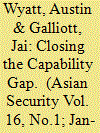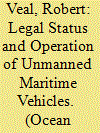| Srl | Item |
| 1 |
ID:
170974


|
|
|
|
|
| Summary/Abstract |
The procurement of autonomous weapon systems is on the rise in Southeast Asia, where, as in other parts of the world, interest in the military applications of unmanned systems is outpacing fractured international regulation efforts. This article analyzes the diffusion of drone technology in Southeast Asia and argues that we are at an inflection point, representing an opportunity for The Association of Southeast Asian Nations (ASEAN) to control the diffusion of unmanned platforms and take a leadership role in developing a regionally appropriate framework for their development. Moreover, it contends that with a regional framework in place to reduce tensions/misadventure, unmanned aerial and maritime vehicles (UAVs & UMVs) could improve ASEAN’s ability to respond to traditional and non-traditional security threats, and thus increase regional security.
|
|
|
|
|
|
|
|
|
|
|
|
|
|
|
|
| 2 |
ID:
165118


|
|
|
|
|
| Summary/Abstract |
The number of unmanned maritime vehicles (UMVs) and their potential applications in the marine space are growing constantly. Because of their comparatively small size and limited operations, only modest attention has been paid to how they fit into the international legal framework. Many UMVs may not be considered to fall under the definition of "ship" so as to enjoy states' rights of navigation under UNCLOS. Therefore states, manufacturers, and investors remain uncertain about the rights and obligations regarding UMV operations in the various maritime zones. This article addresses these questions for a range of UMVs with differing levels of autonomy. It argues that the international legal framework delegates the question of whether a UMV is a ship or not to the flag state's national laws. The article suggests that such a determination will be binding on other states. With respect to UMVs that do not fall under the definition of ship, there is remaining uncertainty about whether any navigational rights in the jurisdictional zones of other states are available, while it is argued that such rights do exist in the areas beyond national jurisdiction. The article also considers the extent to which today's UMVs can comply with the international framework for ensuring safety at sea. For those UMVs falling under the definition of ship, compliance with the current regulatory framework for shipping is required and compliance will be more difficult as the level of UMV autonomy increases.
|
|
|
|
|
|
|
|
|
|
|
|
|
|
|
|